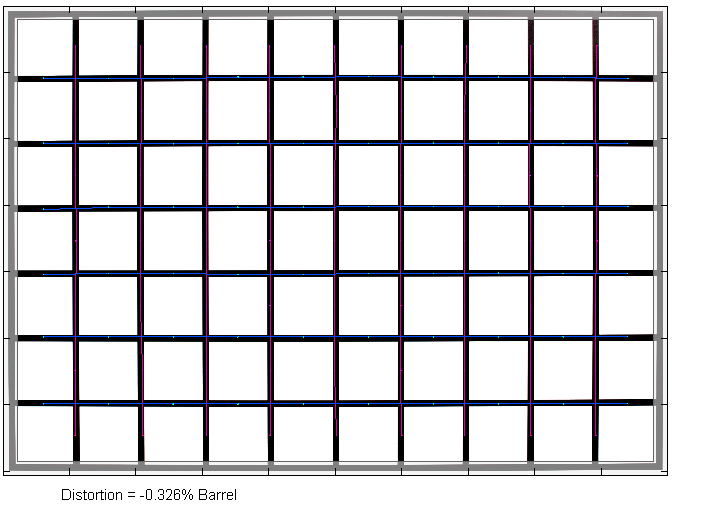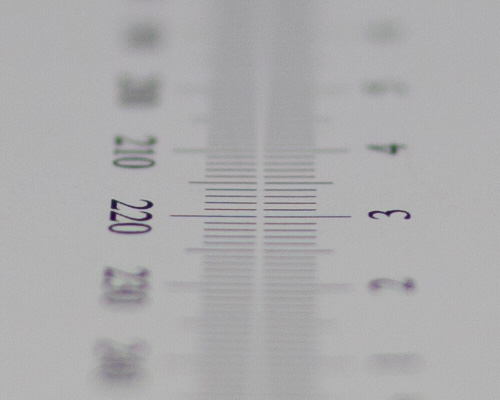|
Sigma AF 35mm f/1.4 HSM DG | A ("Art") - APS-C Format Review / Test Report - Analysis |
|
Lens Reviews -
Canon EOS (APS-C)
|
|
Page 2 of 2

Distortion
The lens shows a small amount of just 0.3% barrel distortion, which is really negligible.

Vignetting
In the APS-C scope the full format Sigma enjoys a sweet spot advantage since only the center portion of the image field is used. Thus the vignetting is drastically reduced here. However, at f/1.4 there's a comparatively high mount of light falloff (1EV). The issue is negligible from f/2 onward though.

MTF (resolution)
The Sigma 35mm f/1.4 USM DG | A delivered stunning results in our full-format tests. The performance in the APS-C scope are still pretty good but the border performance is slightly worse that you might have expected. While the higher pixel density takes its toll, this also suggests a slight mid-field weakness which we also observed in our Nikon APS-C review. The center quality remains outstanding straight from f/1.4 including a very high contrast here. The outer image region reaches good results at large aperture settings so that's far from being bad anyway. The peak performance is reached around f/5.6 with an excellent center and very good borders/corners. At f/11 (and beyond), diffraction limits the maximum resolution again but the quality remains easily on very good level here.
It is worth mentioning that the lens showed no focus shift when stopping down (residual spherical aberration).
Please note that the MTF results are not directly comparable across the different systems!
Below is a simplified summary of the formal findings. The chart shows line widths per picture height (LW/PH) which can be taken as a measure for sharpness.
If you want to know more about the MTF50 figures you may check out the corresponding Imatest Explanations

Chromatic Aberrations (CAs)
Chromatic aberrations (color shadows at harsh contrast transitions) are very well controlled showing readings below an average pixel width of around 0.5px at the image borders. This is nothing to worry about.

Bokeh
One of the primary usage scenarios for a large aperture lens is to seperate the main subject from the background. In such an image the quality of the bokeh (out-of-focus blur) is of major significance.
The lens generally delivers quite smooth bokeh for a wide angle prime but it is not perfect here. In our test scene below the Sigma shows a tad of nervousness in the focus transition zones - more so towards the more critical background.
 Thanks to 9 rounded aperture blades, background highlights retain their circular shape in the relevant aperture range. Thanks to the APS-C format, there're no "cat's eyes" in the image field. There is almost no outlining in the disks formed by highlights, but the discs show a slight onion-like substructure.
Thanks to 9 rounded aperture blades, background highlights retain their circular shape in the relevant aperture range. Thanks to the APS-C format, there're no "cat's eyes" in the image field. There is almost no outlining in the disks formed by highlights, but the discs show a slight onion-like substructure.

Bokeh Fringing / Longitudinal Chromatic Aberrations (LoCA)
LoCAs (non-coinciding focal planes of the various colors) are a common issue with relatively fast glass. As you can notice below the halos have different colors - magenta (red + blue) in front of the focus point and green beyond. Truly "apochromatic" lenses don't show LoCAs but these lenses are very rare especially below 100mm. Unlike lateral CAs, LoCAs cannot easily be fixed in post processing.
Typical for most fast primes, especially ultra fast ones, the Sigma shows some amount of bokeh fringing at large aperture settings, which can of course be reduced by stopping down. The issue is mostly gone from f/2.8 onward.
In addition, these shots also illustrate that there is no focus shift when stopping down, as it was already mentioned in the MTF section.
|
Move the mouse cursor over the f-stop marks below to observe the respective LoCAs
|
| f/1.4 |
f/2 |
f/2.8 |
f/4 |
|

|
VerdictThe Sigma AF 35mm f/1.4 HSM DG | A impressed us during our full-format tests but it can't completely fulfill our very high expectations in the APS-C scope. Now, the center quality remains nothing short of breathtaking especially considering its ultra large aperture. However, normally the "APS-C border" figures tend to be better compared to the "full-format borders" simply because they are physically closer to the better center. However, this is not the case here. At large apertures the results are still good and it "takes a while" till the very good peak performance is reached around f/5.6. Since most users are probably either shooting at max. aperture or around f/8 this is a lesser issue in the real world though. CAs well-controlled and distortions are basically absent. Vignetting is somewhat pronounced at f/1.4 but rather irrelevant beyond. The bokeh quality is not as dreamy as on fast portrait (tele) lenses, but good within its class.
A very positive surprise is the build quality of the lens. It feels like a premium product. Talking about "premium": while the Sigma is more affordable than its main competition, it's still an expensive lens in absolute terms, retailing at around 800EUR/900US$ at the time of this review. Thanks to a HSM drive, the AF is silent and very fast.
The lens remains a highly interesting beast for its high speed alone. However, if you don't plan to upgrade to a full-format camera anytime soon, you may also consider its cheaper cousin - the Sigma AF 30mm f/1.4 DC HSM | A - which is just as fast but more light-weight and, of course, more affordable. Soon to be seen in this theater as well (in Nikon mount at least). :-)
|